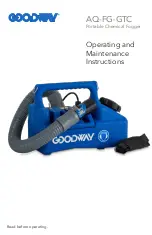
28
SB-510-3
6.3
シャフトシール
シャフトシールの定期点検は基本的に必要
ありません。
しかし、運転信頼性を高めるために、オイ
ル交換時、または潤滑回路で異常が発生し
た後にシールを点検することを推奨します。
点検を行う際には特に以下に注意してくだ
さい。
• O
リングの硬化や亀裂
•
摩耗
•
引っかき傷
•
堆積物
•
オイルカーボン
•
銅被膜
1
運転時間あたり
0.2 cm
3
以下の漏れは許
容範囲に含まれます。漏れたオイルは、シャ
フトシールフランジ上のドレンパイプから
排出することができます。
新品のシャフトシールの慣らし運転中(約
250
時間)
、オイルの漏れる量が増える場合
があります。
7
運転停止
7.1
運転停止
コンプレッサーを取り外すまで、オイルヒー
ターはオンにしておいてください。これは
オイルへの冷媒の溶け込みを防ぐための措
置です。
7.2
コンプレッサーの取外し
取り外して修理を行う必要がある場合や運
転を停止する場合の手順:
コンプレッサーのシャットオフバルブを閉
じ、冷媒を抜き取ります。冷媒は放出せず、
環境保護規定に従って廃棄してください!
!
警告!
コンプレッサーには圧力がかかってい
る場合があります。
重傷を負う危険があります。
安全メガネを着用してください!
コンプレッサー弁のネジ付きジョイントま
たはフランジを緩めます。必要に応じてリ
フト装置を使用し、コンプレッサーを取り
外します。
6.3 Shaft seal
It is not necessary to make a regulary
routine inspection of the shaft seal.
In order to increase operating
reliability it is however recommend to
check the seal in conjunction with an
oil change or after faults in the
lubrication circuit.
Special attention should be given to:
• hardening and cracking of the
O-ring and to
• wear,
• scoring,
• material deposits,
• oil coke and
• copper plating.
Leakage oil quantities up to 0.2 cm
3
per hour are within the permitted
tolerance range. Any possible oil
leakage can be drained via a drain
pipe on the shaft seal flange.
During the running-in period of the
new shaft seal (about 250 hours) an
increased oil leak rate may occur.
7 De-commissioning
7.1 Standstill
Keep the oil heater switched on until
dismantling the compressor! This
prevents increased refrigerant
diffusion in the oil.
7.2 Dismantling the compressor
For repair work, that makes
dismantling necessary, or when
decommissioning them:
Close the shut-off valves at the
compressor. Extract the refrigerant.
Do not release the refrigerant but
dispose it properly!
!
Warning!
Compressor can be under
pressure!
Severe injuries possible.
Wear safety goggles!
Open the threaded joints or flanges at
the compressor valves. Remove the
compressor if necessary with a
hoisting tool.
6.3 Wellenabdichtung
Eine routinemäßige Überprüfung der
Wellenabdichtung ist im Regelfall
nicht erforderlich.
Im Hinblick auf erhöhte Betriebs-
sicherheit empfiehlt sich jedoch eine
Überprüfung im Zusammenhang mit
Ölwechsel oder Störungen im
Schmierkreislauf.
Dabei besonders achten auf:
• Verhärtungen und Risse an den
O-Ringen sowie auf
• Verschleiß,
• Riefen,
• Material-Ablagerungen,
• Ölkohle und
• Kupferplattierung.
Leckölmengen bis ca. 0,2 cm
3
pro
Betriebsstunde liegen im zulässigen
Toleranzbereich. Eventuell
austretendes Lecköl kann über ein
Ölablauf-Rohr am Flansch der Wellen-
abdichtung abgeführt werden.
Während der Einlaufzeit der neuen
Wellenabdichtung (ca. 250 Stunden)
kann eine erhöhte Leckölmenge
austreten.
7 Außer Betrieb nehmen
7.1 Stillstand
Bis zur Demontage Ölheizung
eingeschaltet lassen. Das verhindert
erhöhte Kältemittel-Anreicherung im
Öl.
7.2 Demontage des Verdichters
Bei Reparatureingriffen, die eine
Demontage notwendig machen, oder
bei Außer-Betriebnahme:
Absperrventile am Verdichter schlie-
ßen. Kältemittel absaugen. Kältemittel
nicht abblasen, sondern umwelt-
gerecht entsorgen!
!
Warnung!
Verdichter kann unter Druck
stehen!
Schwere Verletzungen möglich.
Schutzbrille tragen!
Verschraubungen oder Flansche an
den Verdichter-Ventilen öffnen. Ver-
dichter ggf. mit Hebezeug entfernen.
Содержание OSK85
Страница 30: ...30 SB 510 3 Notes...
Страница 31: ...31 SB 510 3 Notes...





































